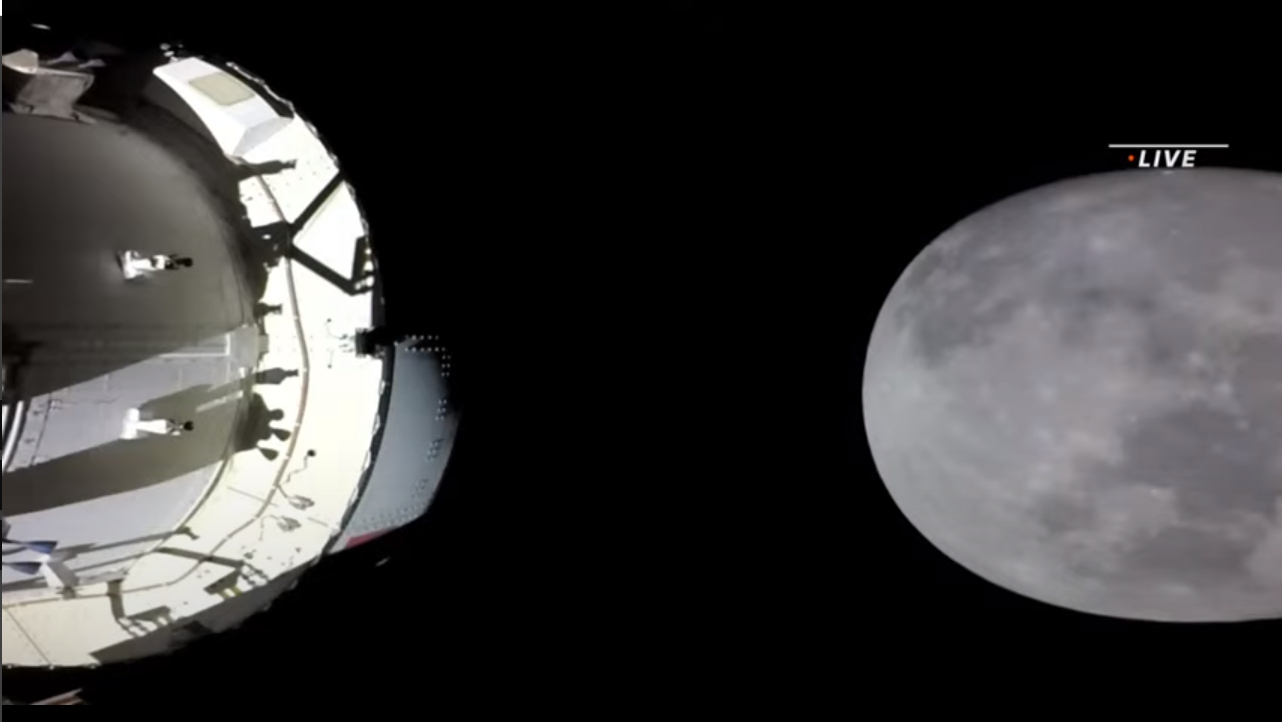Artemis 1 Orion spacecraft on track for return to Earth after moon flyby
Orion is coming home.
For NASA's Orion spacecraft, the next stop is home.
The uncrewed spacecraft flying on NASA's Artemis 1 mission passed a major milestone in its mission today (Dec. 5) when it successfully performed a 207-second engine burn while just just 79 miles (128 kilometers) above the lunar surface. The maneuver placed Orion on track to return home, where it will splash down in the Pacific Ocean on Dec. 11, if all goes according to plan.
And in a media teleconference on Monday (Dec. 5), Orion spaceccraft mission managers asserted that so far, that's exactly how everything is going. "Everything that vehicle was asked to do, it's done. And it's done it phenomenally," said Judd Frieling, flight director at NASA's Johnson Space Center (JSC).
Related: Artemis 1 Orion spacecraft completes crucial moon flyby for trip home

Mike Sarafin, Artemis mission manager at NASA Headquarters in Washington, spoke more poetically during the teleconference about the incredible feats Orion has already performed, such as breaking the human-rated spacecraft distance record previously set by Apollo 13. "We got to see the Earth transit behind the moon extending beyond the pale of human spaceflight. We got to see a flyby of the moon as part of the return powered flyby and witness the Earthrise for the first time in the Artemis generation," Sarafin told reporters. "When we're done with this mission, we will have traveled over 1.4 million miles in the course of the 26-day mission. And we are on track to do that."
That's not to say that every aspect of Orion's maiden voyage is going smoothly. Mission managers also discussed a pair of anomalies the spacecraft encountered in recent days, which include a communication outage and an anomaly with a power system aboard Orion.
Mission managers described during tonight's teleconference how a site-wide outage at the Deep Space Network site in Goldstone, California caused a four-and-a-half hour disruption in communication between ground controllers and Orion. Luckily, the outage was caused by a hardware issue at the ground station and not by any Orion hardware, allowing teams the opportunity to quickly reestablish contact.
Get the Space.com Newsletter
Breaking space news, the latest updates on rocket launches, skywatching events and more!
Additionally, a power conditioning distribution unit onboard Orion malfunctioned on Sunday (Dec. 4), cutting off power to four devices responsible for the vehicle's propulsion and heating subsystems. Power was swiftly restored, however, and NASA wrote in a statement that power to Orion's critical systems, navigation or communication systems was never interrupted.
"We talked through that today, as a mission management team, and the spacecraft is fine. There's plenty of redundancy on the vehicle," Sarafin said today about the power anomaly. "And that in combination with timely work by our operations teams really resulted in no mission impact and no concern there."
Even the Callisto voice-activated digital assistant onboard Orion is performing well, according to Debbie Korth, Orion Program deputy manager at JSC. "First of all, on performance so far, it's been really great," Korth said about Callisto. "I got to witness several of the sessions - very, very interactive, very engaging, in terms of being able to talk to the spacecraft, turn lights on and off, write notes or play music, ask questions. It's just a really very good engagement opportunity and I think it has some potential for how we would use that further."
There are still a few tests to conduct while Orion's shakedown flight is still underway, but as of now, the mission is proceeding so smoothly that mission managers are now looking forward to the next "pre-planned decision gate" that will occur on Thursday (Dec. 8) when a landing site off the coast of California is selected for Orion's Dec. 11 landing.
A complex range of factors including wind speed, wave height and wave period (the time between waves) will be taken into consideration to determine where in the Pacific Ocean to land Orion. NASA and U.S. Navy teams are already coordinating ahead of the recovery operation that will see Orion fished from the sea and brought back to land for analysis.
Follow Brett on Twitter at @bretttingley. Follow us on Twitter @Spacedotcom or on Facebook.
Join our Space Forums to keep talking space on the latest missions, night sky and more! And if you have a news tip, correction or comment, let us know at: community@space.com.

Brett is curious about emerging aerospace technologies, alternative launch concepts, military space developments and uncrewed aircraft systems. Brett's work has appeared on Scientific American, The War Zone, Popular Science, the History Channel, Science Discovery and more. Brett has English degrees from Clemson University and the University of North Carolina at Charlotte. In his free time, Brett enjoys skywatching throughout the dark skies of the Appalachian mountains.









